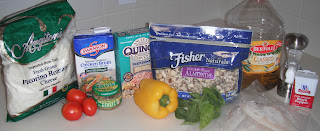Recipe 12: Lean beef meatballs and portabella mushrooms
serves 2-3
Ingredients
1lb lean ground beef
1 egg
15-20 basil leaves
1 tablespoon garlic
1/3 cup breadcrumbs
1 tablespoon oregano
½ cup grated parmesan (the real stuff, not the
unrefrigerated Kraft stuff)
1 tablespoon Olive oil
1 Jar tomato sauce (use your preferred)
1 cup water
3 portabella mushroom caps
Directions
To make meatballs, add beef, egg, chopped basil leaves,
garlic, breadcrumbs, oregano, parmesan, and olive oil to a mixing bowl. Use
your hands to mix all ingredients together. Do not over mix or meat will be
tough. Form balls slightly larger than a golf ball and add to a preheated pan
(on medium). When all meatballs are in the pan, reduce heat to simmer and add
tomato sauce and water. The water is needed to keep the sauce from burning.
Allow to simmer for 2-3 hours gently stirring one time per hour. During the
last 15-20 minutes of cook time add sliced mushroom caps and gently stir. If
desired, serve over pasta.
What will you gain by eating this
meal? (sources http://www.webmd.com and
www.livestrong.com) and “99 Superfoods” by Carrie May
Lean beef: 6oz of lean beef supplies 100% of an adults
protein for the day. And as long as the beef is LEAN it is low in cholesterol
and provides iron that your body needs to form red blood cells, which prevents
anemia. Lean red meat also has a good amount of zinc which supports a healthy
brain and immune system.
Egg: Because eggs
contain cholesterol they have gotten a negative reputation. This website
outlines several of the benefits to eating eggs. They are one of the few foods
that contain vitamin D. Woman who eat 6+ eggs a week are said to be at a lower
risk of breast cancer. Eggs are a wonderful, low calore source for protein.
They strengthen eye health and are full of antioxidants. http://www.healthdiaries.com/eatthis/10-health-benefits-of-eggs.html
Basil: 2 tsp of basil contain 60% of your Vitamin K for the
day. Vitamin k is important for normal blood clotting and cell growth
(according to WebMD) If you have a shortage you may bruise easy, have
nosebleeds or weak bones.
Garlic: garlic contains sulphur (which is responsible for
its strong smell and flavor). The sulfide allicin helps regulate blood
cholesterol. It is high in selenium, which strengthens the immune system and
will help you fight off colds, other viral diseases, and protect you from
cancer. (the National Institutes of Health claim that higher selenium intake
reduces the risk of death from lung cancer)
Oregano: Oregano is high in antioxidants. Antioxidants are
what fights and prevents the development of diseases such as cancer and
arthritis. Similar to basil, It also has antibacterial and antifungal
quantities.
Cheese: Source of calcium which is necessary for strong
bones and teeth. Low calorie cheese contains less lactose than full fat cheeses
so if you have an allergy, low fat cheese may not upset your stomach.
Olive oil: Omega-9 fatty acid which helps reduce the risk of
heart disease
Tomato: are rich in lycopene, which is a carotenoid. Fruits
and vegetables rich in carotenoids are bright red. Lycopene will reduce your
risk of developing osteoporosis and help prevent macular degeneration. Eating
high levels of lycopene have proven to ward off many cancers. There is no other
food as rich in the antioxidant as the tomato. http://healthfood-guide.com/tomatohealthbenefits.aspx
Mushrooms: portabello mushrooms provide selenium, copper,
phosphorus and potassium. According to whfoods.org, copper helps your body
utilize iron (which prevents anemia), reduce tissue damage, maintain healthy bones
and tissue, produce melanin (which gives your skin color), maintains normal
thyroid function, and protects your nerves.

























